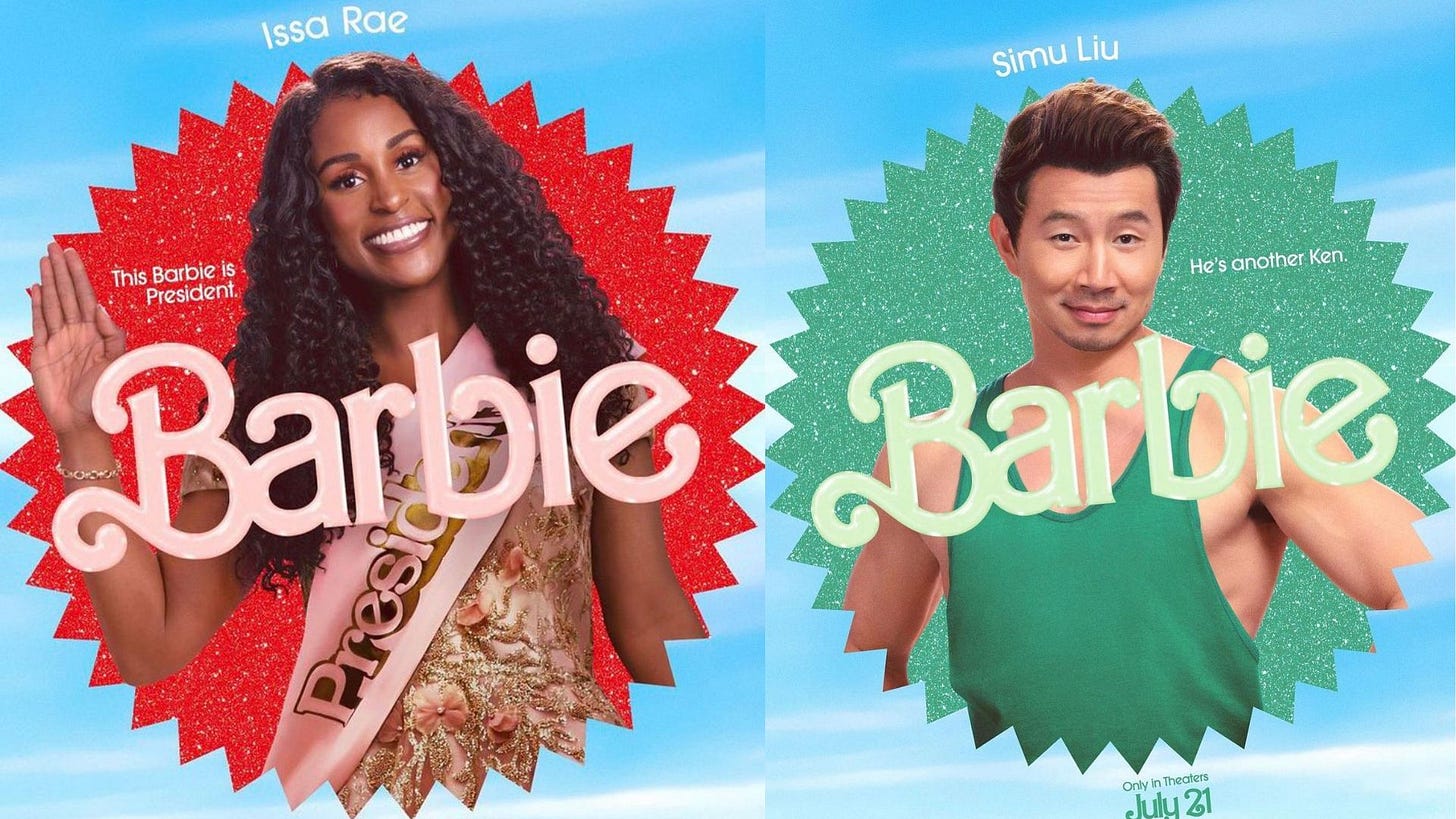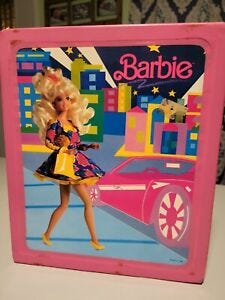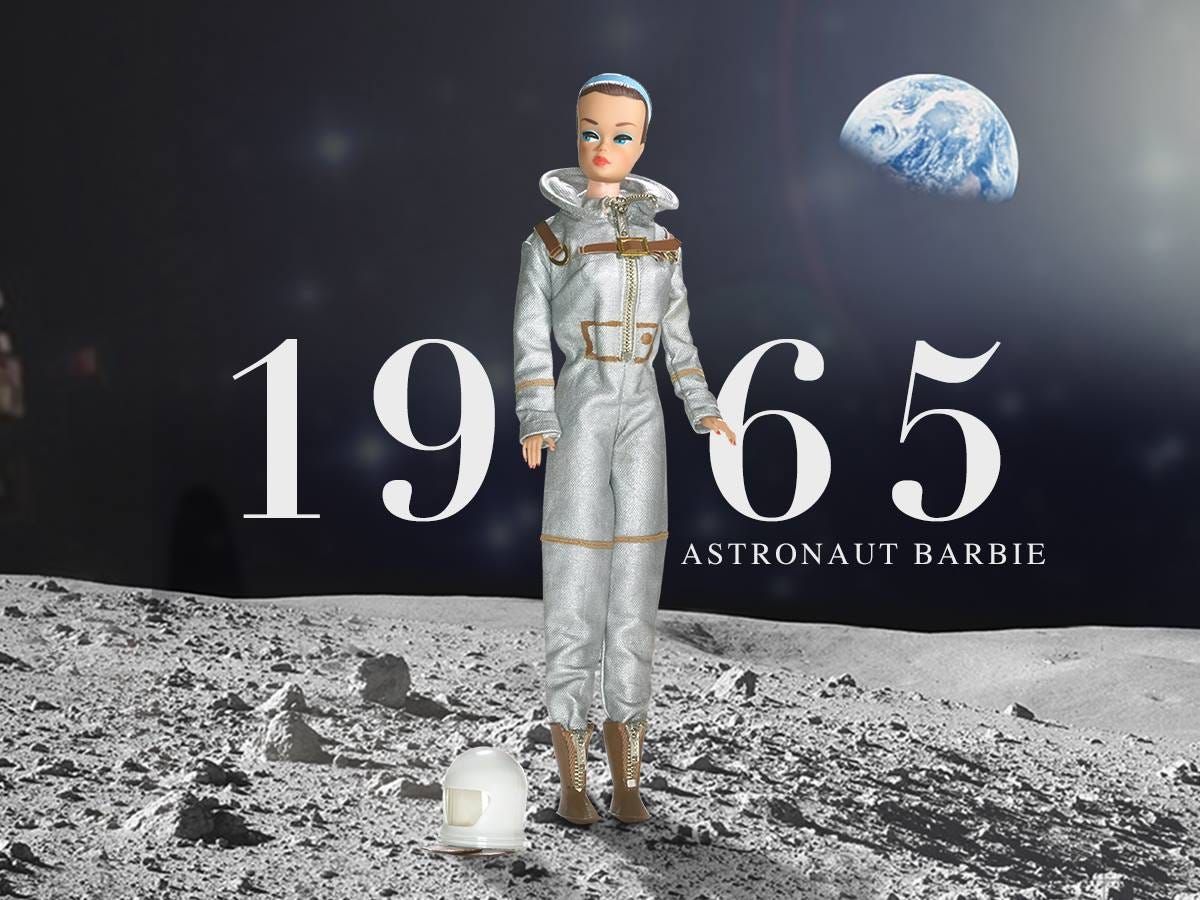This may have happened to you: two weeks ago you were going about your day, idly checking Instagram when suddenly everything was Barbie. Barbie Barbie Barbie. The new Barbie Movie trailer just dropped, accompanied by an AI art campaign where you could become the iconic doll. All the cast members had their own: Issa Rae’s Barbie is president! Simu Liu’s Ken is…another Ken!
Barbies (I’ve only written this word nine times so far and I’m already getting annoyed by the pop of the Bs and the screech of the “ees”) were everything if you were a girl growing up in the early 90s.1 Sure you had your Cabbage Patch Kids and soon your Beanie Babies, but Barbies were incomparable. They were compact, fashionable, and ubiquitous. I could always spot the Barbies on gift tables at birthday parties at that age: even wrapped you couldn’t miss its distinctive narrow rectangular shape. We’d rip open the wrapping paper to reveal a precious pink cardboard and plastic box with our new friend, a facsimile of the many Barbies we already had, but maybe with tiny sneakers and a ballcap instead of tiny high heels and a purse. Mattel has always been advertising geniuses convincing us that we needed to ask for every version of this white, blonde plastic doll.2 And not just that, but outfits, accessories, furniture, houses, cars, and a timeshare in Boca. My mother collected them too, keeping them pristine in their boxes with the intention to sell them later; I pined to play with her fancy, classy Barbies as they sat forbidden in her closet.
My mother was always very generous and made sure that my dolls had all the things they needed to live well-rounded doll lives. I had a Barbie minivan (my Barbies were sensible, none of this Corvette business) that they would take to the Barbie Dreamhouse (not in Malibu). I had a large rubber carrying case (pink of course) that was meant to keep everything together but rarely did–you can probably still find one single Barbie shoe embedded in the carpet of the play room of my childhood home. We regularly went to Toys ‘R Us to make sure Barbie was outfitted in the latest fashions (lots of bright colors, it was the 90s). My mother went wild on QVC one day and gifted me a pink hardshell Barbie dressing room and closet (it had storage and a mirror for Barbie to have her own fashion show montage with her friends) and myriad other accouterments, including Barbie rollerblades that sparked and roared like a striking match.
My favorite Barbie was the 1996 Olympic Gymnast Barbie.3 She was unlike any I had ever seen before: her arms and legs were attached with ball sockets and were far more posable than her boring friends who could only lift and lower their arms in a linear fashion and whose legs had a slight bend but could only move like a scissor. This girl could do a saddle split! Regular Barbie could never pull this off (literally, you’d have to rip her legs off to do that and she’d never be the same). Like many millennial girls, I was obsessed with the 1996 US Women’s Gymnastics team. This Barbie had the functionality to mimic their moves, doing a whole floor routine with aplomb, flying high as she flipped and turned across the playroom carpet that served as my Barbie gym mat. Of course this Barbie was a gold medal winner (move over Shannon Miller).

Despite my love for Barbie, I wasn’t always the best friend to her. Her hair was often matted or mussed (in fact I wasn’t able to play with my sister’s Barbies because she thought mine were too messy; hers were pristine). I gave one Barbie a haircut so short my mother called her Susan Powter. My mother also reminds me (more frequently than I think is strictly necessary) of the time she walked into the playroom and I had a naked Ken doll sitting in the middle of a circle of naked Barbies. No comment.
Sadly, Barbie can be problematic. Barbie represents the fascination with consumerism and impossible (white) beauty standards. Barbie had eternally perfect makeup, a killer style with a closet that rivaled Cher Horowitz’s, and physically impossible measurements.4 In recent years, Mattel released other body versions of Barbie, including tall, petite, and curvy. But even “curvy” Barbie is a size 4. The average American woman is size 14. Barbie’s boyfriend Ken, little sister Skipper, and friends Midge and Christie also embodied this unattainable perfection, as if they’ve all just returned from a day at Malibu Beach, healthy and tanned. Given the chokehold they had on my peer group, the advertising depicting Barbie as the platonic ideal of womanhood, and the awkwardness of childhood trying to understand our place in the world, Barbie is actually a bit dangerous.
Perhaps that is why Mattel has leaned more into Barbie’s careers since the early 90s. Career Barbies are of course another way that Mattel can sell us more versions of the same thing, but at least serve as a quasi-educational tool to showcase different career paths anyone could take. According to my research,5 Barbie has had over 200 careers and started out in the business world in 1959 when she debuted. Early careers tended to focus on traditionally feminine jobs (babysitter, ballerina, flight attendant, nurse, candy striper), but Mattel also offered a Barbie business executive in 1959 and 1963, and an astronaut in 1965. Apparently Barbie went to the moon before Apollo 11 did!
If you scroll through the list, there are many fallow years at the start of Barbie’s journey where she had no new careers (I guess she’ll have to explain that gap in her resume). Besides Barbie’s journey to the moon and two stints in the corporate boardroom, her jobs remained mostly stereotypical until the late 80s/early 90s when things start to get interesting: pilot in 1989, presidential candidate in 1992 and 2000 (take that Bushes!), pediatrician in 1995 and 1996, and paleontologist in 1996, among many others. Or according to Twitter, a meth lab owner and operator (always a business executive). More recently she’s embraced more careers in STEM.

While this is still consumerism at its best (I mean, you can buy McDonalds, See’s Candies, and Pizza Hut cashier Barbies), I kind of love that this is the direction that Barbie has taken. It doesn’t compare to seeing actual human women (particularly women of color) doing these careers, but Barbie does help to do a small part for young children to see that things are possible–whether it's a career in STEM or a career in retail or the service industry. Let’s go Empowerment Barbie! She lives in Malibu.
Barbie is going to represent something different to everyone. Some may find her to be an ideal or something they will never attain. An inspiration or a joke. A representation of ambition or popularity and perfection. Barbie has her own room in the Museum of My Nostalgia. Not just because of her truly iconic status in pop culture, but because of the joy she gave me, how I loved having a way to connect to my sister and friends, and how I got to express my creativity by dressing them in wacky outfits and style their hair (or cut it off). Barbie felt like a friend–perhaps one that was a little too perfect but she meant well. How when you were five she was an unconditional friend and less a symbol of heteronormative gender roles. She could be anything you wanted her to be, even if that meant a sloppy mess (but a sloppy mess in Malibu).
Come on Barbie, let’s go party.
Thank you so much for subscribing! A big thanks to Substack for featuring The Museum of My Nostalgia which led so many of you here. I’ve hit 100 subscribers (thanks Kim!) and appreciate every single one of you.
All genders love Barbie and have played with and cherished her since she debuted in 1959. For the purposes of this piece, I am focusing on people who were socialized as girls as children, as this is my experience.
This reminds me of a classic Dana Carvey bit from his 1995 HBO special about action figures that is forever in my memory, ready to be quoted at any time.
Apparently, this Barbie doubled as a rhythm gymnast: she came with a long ribbon tied to her wrist.
OG Barbie would have been 5’9”, 36x18x33, and severely underweight at 110 pounds.
Wikipedia.








Loved this trip down memory lane. Just gave my Barbies and my daughters to my grandchildren. Can never have enough Barbies.
As a father to a young daughter, the Barbie thing is all new to me. You capture some of what makes the brand appealing but also... strange.
Thanks so much for this